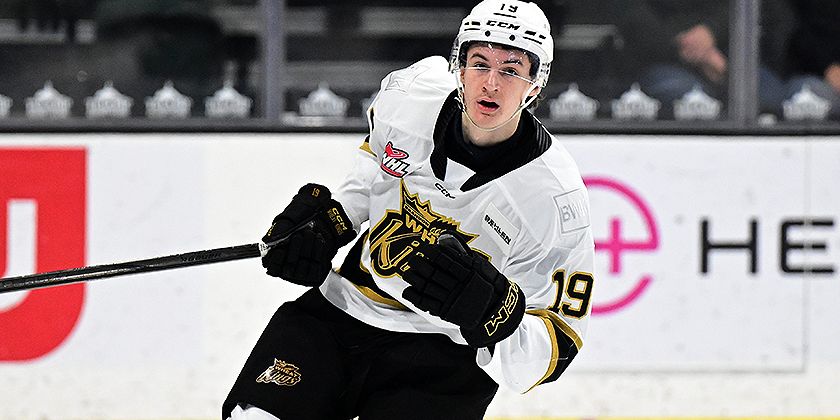
Carter Klippenstein (LW, L, 6’3″, 180, Brandon Wheat Kings, 11/25/2006)
Case for Carter Klippenstein as an NHL Draft Pick
Pro-Size and Strength
6’3″, 180 lbs—has an NHL frame that can be developed further with added strength, explosiveness and muscle mass.
Engages in 14 puck battles per game and draws 0.50 penalties per game – he is difficult to contain physically.
1.98 hard hits per game—a strong physical presence who is not afraid to play a heavy game.
Uses his frame well along the boards and in tight areas, giving him potential as a power forward or shutdown depth forward at the next level.
Defensive Awareness & Versatility
Logs 1:44 of penalty kill time per game – earns trust from his coaching staff in defensive situations.
Almost even split in offensive zone time (6:58) and defensive zone time (7:08) – he doesn’t cheat for offense and plays a reliable two-way game.
Can play both wing and center, giving him added versatility and lineup flexibility.
Compete Level and Work Ethic
2.7 takeaways per game—shows an ability to disrupt play and force turnovers.
High motor and work ethic; battles hard and competes in all three zones.
+18 rating (4th highest on team) – he is trusted and contributes positively in even-strength play.
Not afraid to absorb contact, receiving 0.96 hard hits per game while continuing to play his role effectively.
Transitional & Offensive Tools
Above average first step and agility for a big young forward, allowing him to evade pressure and maintain possession.
3.5 shot attempts per game and 2.2 Grade “A” scoring chances per game—puts himself in good scoring positions consistently.
Showcases hockey IQ with smart positional play and intelligent passing decisions in key moments.
Case Against Carter Klippenstein as an NHL Draft Pick
Lack of High-End Offensive Upside
Only 12 goals and 25 points in 44 games—does not project as a secondary scoring forward at the professional level.
11% conversion rate on Grade “A” scoring chances – he needs significant improvement in his finishing ability (deception, shot release, and one-timer mechanics).
0.71 passes per game leading to a teammate’s shot— limited playmaking ability.
Inconsistent Puck Management
5.2 giveaways per game—far too high, especially for a player his size who is not a high-volume offensive creator.
85% pass completion rate is very average – he will need to improve his decision-making with the puck for a chance at a National League depth role.
Tends to overcomplicate puck possession or hold onto the puck too long allowing smaller players to play beneath his hips, leading to unforced turnovers.
Weak 50/50 Battle Win Rate for His Size
Wins just 44% of 50/50 puck battles—needs to lower his hips to use his frame more effectively to establish inside positioning and win possession consistently.
This percentage should be much higher for a 6’3″ forward who plays a power game in junior hockey.
Will benefit from adding core stability and lower-body strength to improve balance and leverage in board battles.
Face-Off Ability
Wins 46% of his face-offs but only takes 2 face-offs per game — if he is to be trusted in high leverage defensive situations, this must improve and is an area for focused development.
Right now, he is more suited to play the wing.
Final Verdict: Draftable or Not?
Draftable in the Middle to Late Rounds (4th-6th Round) Based on Upside as a Two-Way, Bottom-Six NHL Forward
Why Draft Him?
NHL-caliber size and strength—long frame that can add weight and muscle.
Responsible two-way game—trusted defensively and contributes positively in even-strength situations.
Hard worker and physical presence—plays a heavy, forechecking style that can translate to a bottom-six NHL role.
Projects as a reliable depth forward who can forecheck effectively, potentially intimidate through physicality, and provide secondary offense.
Why Not Draft Him?
Limited offensive upside—likely not an offensive contributor at the NHL level.
Needs to improve his finishing ability—low shooting percentage on high-danger chances.
Puck management issues—turnover-prone and needs better decision-making under pressure.
Struggles in face-offs and 50/50 battles despite size, which raises concerns about his ability to play minutes at the NHL level.
Projection:
Best-Case NHL Upside: Shutdown, two-way third-line winger who kills penalties, forechecks hard, and chips in secondary / complimentary offense.
Likely Path: Drafted in 4th-6th round → WHL development → AHL for seasoning → NHL bottom-six contributor.
Draft Range: Mid-to-late round pick (4th-6th round).
Conclusion:
Carter Klippenstein has the size, physicality, and defensive awareness that NHL teams look for in a bottom-six checking-line forward. However, his offensive game remains a work in progress, and his puck management needs development and consistency. If a team is looking for a big, versatile forward with strong defensive instincts and the potential to develop into a depth NHL forward, Klippenstein is a solid mid-to-late round draft choice. If his offensive production doesn’t improve, he could top out as an AHL/NHL tweener.
Photo credit: Dan Hickling/Hickling Images
